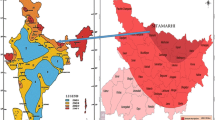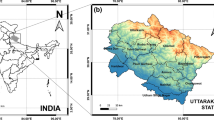Abstract
The districts of Madhubani and Supaul lie near Bihar–Nepal border along foothills of Himalaya. Different attenuation relationships applicable for the Himalayan region have been used to estimate the site-specific Peak Ground Acceleration (PGA) for the Madhubani and Supaul region on the basis of Deterministic Seismic Hazard Assessment (DSHA) study. Seismicity data have been collected from IMD, New Delhi and forty seismotectonic sources were recognized in the region from Seismotectonic Atlas of India (GSI in Seismotectonic atlas of India and its environs, Geological Survey of India, Kolkata, 2000). Hypocentral distances have been measured using ArcGIS software. Maximum Peak ground acceleration value is found to occur for Main Central Thrust fault for both these districts.
Similar content being viewed by others
References
Abrahamson NA, Litehiser JJ (1989) Attenuation of vertical peak accelerations. Bull Seismol Soc Am 79:549–580
Ader T, Avouac J, Zeng J, Lyon H, Bollinger L, Galetzka J, Genrich J, Thomas M, Chanard K, Sapkota SN, Rajaure S, Shrestha P, Ding L, Flouzat M (2012) Convergence rate across the Nepal Himalaya and interseismic coupling on the Main Himalayan Thrust: implications for seismic hazard. J Geophys Res 117:1–16
Ambraseys JJ, Douglas J (2004) Magnitude calibration of north Indian earthquakes. Geophys J Int 159:165–206
Anbazhagan P, Bajaj K, Patel S (2015) Seismic hazard maps and spectrum for Patna considering region-specific seismotectonic parameters. Nat Hazards 78:1163–1195
Ansal MA, İyisan R, Güllü H (2001) Microtremor measurements for the microzonation of dinar. Pure Appl Geophys 158(12):2525–2541. https://doi.org/10.1007/PL00001184
Banghar AR (1991) Mechanism solution of Nepal–Bihar earthquake of August 20, 1988. J Geol Soc India 37:25–30
Borcherdt RD (1994) Estimates of site-dependent response spectra for design (methodology and justification). Earthq Spectra 10(4):617–653
Burnwal ML, Burman A, Samui P, Maity D (2017) Deterministic strong ground motion study for the Sitamarhi area near Bihar–Nepal region. Nat Hazards 87(1):237–254
Campbell KW (1981) Near-source attenuation peak horizontal acceleration. Bull Seismol Soc Am 71(3):2039–2070
Campbell KW (2003) Strong-motion attenuation relations. In: Lee WHK, Kanamori H, Jennings PC, Kisslinger C (eds) International handbook of earthquake and engineering seismology, part B. Academic Press, Burlington, pp 1003–1012
Central Ground Water Board (2013) Ground water information booklet for Madhubani and Supaul Districts, Bihar State. Ministry of Water Resources (Govt. of India) Mid-Eastern Region Patna
Dasgupta S (1993) Tectono-geologic framework of the eastern Gangetic foredeep. Spec Publ Geol Surv India 31:61–69
Dasgupta S, Mukhopadyay M, Nand DR (1987) Active transverse features in the central portion of the Himalaya. Tectonophysics 136:255–264
Geological Survey of India (2007) www.gsi.gov.in
Güllü H (2012) Prediction of peak ground acceleration by genetic expression programming and regression A comparison using likelihood based measure. Eng Geol 141–142:92–113. https://doi.org/10.1016/j.enggeo.2012.05.010
Güllü H (2013) On the prediction of shear wave velocity at local site of strong ground motion stations: an application using artificial intelligence. Bull Earthq Eng 11:969–997
Güllü H (2014) A factorial experimental approach for effective dosage rate of stabilizer: an application for fine-grained soil treated with bottom ash. Soils Found 54(3):462–477
Güllü H (2015a) On the viscous behavior of cement mixtures with clay, sand, lime and bottom ash for jet grouting. Constr Build Mater 93:891–910
Güllü H (2015b) Unconfined compressive strength and freeze–thaw resistance of fine-grained soil stabilised with bottom ash, lime and superplasticiser. Road Mater Pavement Des 16(3):608–634
Güllü H, Ercelebi E (2007) A neural network approach for attenuation relationships: an application using strong ground motion data from Turkey. Eng Geol 93(3–4):65–81. https://doi.org/10.1016/j.enggeo.2007.05.004
Güllü H, İyisan R (2016) A seismic hazard study through the comparison of ground motion prediction equations using the weighting factor of logic tree. J Earthq Eng 20(6):861–884
Güllü H, Jaf HS (2016) Full 3D nonlinear time history analysis of dynamic soil–structure interaction for a historical masonry arch bridge. Environ Earth Sci 75(21):1–17. https://doi.org/10.1007/s12665-016-6230-0
Güllü H, Karabekmez M (2017) Effect of near-fault and far-fault earthquakes on a historical masonry mosque through 3D dynamic soil–structure interaction. Eng Struct 152:465–492. https://doi.org/10.1016/j.engstruct.2017.09.031
Güllü H, Pala M (2014) On the resonance effect by dynamic soil-structure interaction: a revelation study. Nat Hazards 72:827–847
Güllü H, Ansal AM, Özbay A (2008) Seismic hazard studies for Gaziantep city in South Anatolia of Turkey. Nat Hazards 44:19–50
Hayes GP, Briggs RW, Barnhart WD, Yeck WL, McNamara DE, Wald DJ, Nealy JL, Benz HM, Gold RD, Jaiswal KS, Marano K, Earle PS, Hearne MG, Smoczyk GM, Wald LA, Samsonov SV (2015) Rapid characterization of the 2015 Mw 7.8 Nepal (Gorkha) earthquake. Seismol Res Lett 86(6):1557–1567. https://doi.org/10.1785/0220150145
IMD (2010) Seismicity of India for earthquakes of M > 5.0 for the period 1505–March 2010. India Meteorological Department, Govt. of India, New Delhi
IS 1893 (2002) Indian standard criteria for earthquake resistant design of structures, part 1-general provisions and buildings. Bureau of Indian Standards, New Delhi
Iyengar RN (1999) Earthquakes in ancient India. Curr Sci 77:827–829
Iyengar RN, Ghosh S (2004) Microzonation of earthquake hazard in Greater Delhi area. Curr Sci 87(9):1193–1202
Jain V, Sinha R (2005) Response of active tectonics on the alluvial Baghmati River, Himalayan foreland basin, eastern India. Geomorphology 70:339–356
Jain SK, Roshan AD, Arlekar JN, Basu PC (2000) Empirical attenuation relationships for the Himalayan earthquakes based on Indian strong motion data. In: Proceedings of the sixth international conference on Seismic Zonation
Joshi A, Mohan K (2011) Expected peak ground acceleration in Uttarakhand Himalaya, India region from a deterministic hazard model. Nat Hazards 52:299–317
Joshi A, Patel RC (1997) Modeling of active lineaments for predicting a possible earthquake scenario around Dehradun, Garhwal Himalaya, India. Tectonophysics 283:289–310
Joyner WB, Boore DM (1981) Peak horizontal acceleration and velocity from strong motion records including records from the 1979 Imperial Valley, California, earthquake. Bull Seismol Soc Am 71(6):2011–2038
Khattri KN (1987) Great Earthquakes, seismicity gaps and potential of earthquake disaster along the Himalayan plate boundary. Tectonophysics 138(1):79–92
Krishnaswamy VS (1962) Significance of the Moradabad fault in the Indo-Gangetic Basin and other faults in the sub-Himalaya in relation to the Ramganga River project. In: Proceedings of the 2nd symposium on earthquake engineering. University of Roorkee, Roorkee, pp 411–422
Kumar A, Jain R, Gupta SC (2004) Seismic hazard estimation from the isoseismals of three great Indian earthquakes. In: 13th World conference on earthquake engineering, Vancouver, B.C., Canada, August 1–6, 2004, Paper No. 2362
Kumar A, Anbazhagan P, Sitharam TG (2013) Seismic hazard analysis of Lucknow considering local and active seismic gaps. Nat Hazards 69:327–350
Kumar A, Mittal H, Kumar R, Ahluwalia RS (2017) Empirical attenuation relationship for peak ground horizontal acceleration for North-East Himalaya. Vietnam J Earth Sci 39(1):47–57. https://doi.org/10.15625/0866-7187/39/1/9183
Mark RK (1977) Application of linear statistical models of earthquake magnitude versus fault length in estimating maximum expectable earthquakes. Geology 5:464–466
Mittal H, Kumar A, Ramhmachhuani R (2012) Indian national strong motion instrumentation network and site characterization of its stations. Int J Geosci 3:1151–1167
Nath SK, Raj A, Thingbaijam KKS, Kumar A (2009) Ground motion synthesis and seismic scenario in Guwahati City—a stochastic approach. Seismol Res Lett 80(2):233–242
NDMA (2011a) Development of Probabilistic Seismic Hazard Map of India. Technical Report, National Disaster Management Authority, New Delhi
NDMA (2011b) Geotechnical/geophysical investigations for seismic microzonation studies of urban centres of India. Technical Report, National Disaster Management Authority, New Delhi
Pasupuleti PDK, Ramancharla PK (2014) Interactions and seismicity of Indian tectonic plate with its neighboring plates: an overview. Int J Adv Earth Sci Eng. Report no: IIIT/TR/2014/-1
Rastogi BK, Singh AP, Sairam B, Jain SK, Kaneko F, Segawa S, Matsuo J (2011) The possibility of site effects: the anjar case, following past earthquakes in Gujarat, India. Seismol Res Lett 82:59–68
Richter CF (1957) Introduction to seismology. Eurasia publishing house, New Delhi, p 768
SEISAT (2000) Seismotectonic Atlas of India and its environs. Geological Survey of India, Kolkata
Sharma ML (1998) Attenuation relationship for estimation of peak ground horizontal acceleration using data from strong-motion arrays in India. Bull Seismol Soc Am 88:1063–1069
Sharma ML (2000) Attenuation relationship for estimation of peak ground vertical acceleration using data from strong motion arrays in India. In: Proceedings of twelfth world conference on earthquake engineering, paper no. 1964
Singh RP, Aman A, Prasad YJJ (1996) Attenuation relations for strong seismic ground motion in Himalayan Region. Pure Appl Geophys PAGEOPH 147(1):161–180
Tallett-Williams S, Gosh B, Wilkinson S, Fenton C, Burton P, Whitworth M, Datla S, Franco G, Trieu A, Dejong M, Novellis V, White T, Lloyd T (2016) Site amplification in Kathmandu valley during the 2015 M7.6 Gorkha, Nepal earthquake. Bull Earthq Eng 14(12):3301–3315
Thakur VC, Joshi M, Sahoo D, Suresh N, Jayangondapermal R, Singh A (2014) Partitioning of convergence in Northwest Sub-Himalaya: estimation of late Quaternary uplift and convergence rates across the Kangra re-entrant, North India. Int J Earth Sci (Geol Rundsch) 103:1037–1056
Verma M, Singh RJ, Bansal BK (2014) Soft sediments and damage pattern: a few case studies from large Indian earthquakes vis-a-vis seismic risk evaluation. Nat Hazards 74:1829–1851
Wells DL, Coppersmith KJ (1994) New empirical relationships among magnitude, rupture length, rupture area, and surface displacement. Bull Seismol Soc Am 84(4):974–1002
Author information
Authors and Affiliations
Corresponding author
Additional information
Publisher's Note
Springer Nature remains neutral with regard to jurisdictional claims in published maps and institutional affiliations.
Rights and permissions
About this article
Cite this article
Burman, A., Gautam, R. & Maity, D. DSHA Based Estimation of Peak Ground Acceleration for Madhubani and Supaul Districts Near Bihar–Nepal Region. Geotech Geol Eng 38, 1255–1275 (2020). https://doi.org/10.1007/s10706-019-01086-7
Received:
Accepted:
Published:
Issue Date:
DOI: https://doi.org/10.1007/s10706-019-01086-7










